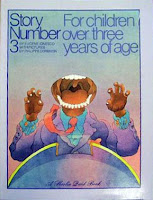 I dug out Eugene Ionesco's four children's books tonight. I commented briefly on them some time back.
I dug out Eugene Ionesco's four children's books tonight. I commented briefly on them some time back.For the most part, they're presented as any children's book you'd expect. Each double page spread has some text, written simply, and an accompanying illustration. It's not really comics since, generally, the words and pictures aren't interdependent. Occasionally, there's a brief sequence of just pictures, but the story remains completely comprehensible if you use the text by itself.
But, as I was going through Story Number 3 tonight, I came across these two pages...


(You'll pardon that they're photos and not scans, as Microsoft opted to make Vista completely NOT backwards compatible with most hardware like, say, my scanner.)
Both pages are still portrayed next to the adjoining text, but they're sequenced internally to themselves, marking a clear and distinct progression of actions. The first sequence clearly shows, from the the narrator's perspective, walking down the hall, opening the door, and finding an old woman, who has some vision of a young girl caught in a tree. (Admittedly, the "vision" portion must read in the text, but the narrator does indeed accost the woman once he sees her, as is shown in the graphics.) The actual text reads:
Papa: After that, we'll go to the end of the hall and then we'll turn left. The hall isn't dark there. It's lit by the light that comes through the living room windows on the left. We come to the kitchen. There is Jacqueline preparing the noon lunch. We'll say to her: "Goodbye, Jacqueline."
Josette: Goodbye, Jacqueline.
Jacqueline will say: "Where are you going, sir?... Where are you going with your papa, my little Josette?"
Josette: We're going on a trip. We're going to fly in an airplane. We're going to the sky.
Jacqueline will say: "Watch Josette carefully when you are up there, sir. She must not lean out of the window; it's dangerous. She might fall. She might get a bump on her forehead falling on the neighbor's roof. Or she might get caught in the branches of a tree by the seat of her underpants. We would have to get a ladder to take her down."
Josette: No, I will be very careful.
One illustration, broken up into four distinct panels depicting the text. that's sequential art, isn't it?
The next illustration is actually on the very next page of the book. It shows Papa and Josette leaving their apartment and taking the elevator down, where they encounter another old woman.
Papa: Then I take the key; I open the door with the key.
Josette: In the keyhole.
Papa: I open the door, I close the door. I don't slam the door; I close it very quietly. I get into the elevator with you, I push the button...
Josette: No, me! I push the button. Pick me up in your arms because I'm too small to reach it.
Papa: I pick you up in my arms. You push the button. The elevator goes down. We have to go down first so that, later on, we can go up. We reach the ground floor. We step out of the elevator, and we see the superintendant's wife sweeping the hall in front of her apartment.
Josette: Good morning, Mrs. Superintendant.
Papa: Then Mrs. Superintendant will say: "Good morning, sir; good morning, my little one. Oh! how pretty she is this morning with her beautiful little coat, with her lovely little boots, with her sweet little gloves!... Oh! what tiny hands!..."
Josette: And my hat.
This particular page strikes me as more interesting since we have only one delineated panel, but the separate floors act as implied panel borders. The act of the characters moving through a single space implies the passage of time and, therefore, the sequence. I discussed that issue back here in reference to an installment of Andy Capp. Here, however, the artist has chosen not to specify the borders as explicitly, though, it's not quite as subtle an indication as I suggested could be done with that Andy Capp strip.
As I noted, Story Number 3 is the only one of the four books to have sequences like that. The first two were illustrated by Etienn Delessert, and the final by Jean-Michel Nicollet. This third volume, however -- the only one with actual sequential art -- is credited to Philippe Corentin, a pseudonym of Philippe Le Saux. Story Number 3 is evidently one of his earlier published works, the most popular (I gather) of which came out in the late 1980s and early 1990s. As near as I can tell, his other works have not been translated into English, so I have to admit to ignorance of whether or not he continued injecting comics into his children's books or not.
Interestingly, Story Number 3 was my least favorite as a child because I found Corentin's illustration style disturbing. All of Ionesco's books have a decidedly dark edge to them, but Delessert's and Nicolett's art somehow seemed to make that more palatable. Now that I'm able to get beyond the really frightening cover, I find that I have more respect for Corentin's work than the others. Not only because of the use of comics in the story, but he also adds a number of subtle touches that speak better to some of the implied meta-textually, adult themes Ionesco wrote into the books.






0 comments:
Post a Comment